Global Economics: Argentina's Economic Policies and Global Challenges
VerifiedAdded on 2023/06/07
|8
|2056
|391
Report
AI Summary
This report provides a detailed analysis of global economics, using Argentina as a case study. It examines Argentina's economic journey, highlighting the impact of currency devaluation, current account deficits, and volatile capital flows on its economy. The report explores the pros and cons of currency devaluation, the challenges posed by current account deficits, and the consequences of expansionary macroeconomic policies in developing countries. It also discusses the role of volatile capital flows in Argentina's economic crises. The report concludes with recommendations for sound economic decision-making and emphasizes the need for careful consideration of both the advantages and disadvantages of economic policies. The analysis draws on various economic concepts and theories to provide a comprehensive understanding of the challenges facing global economies.
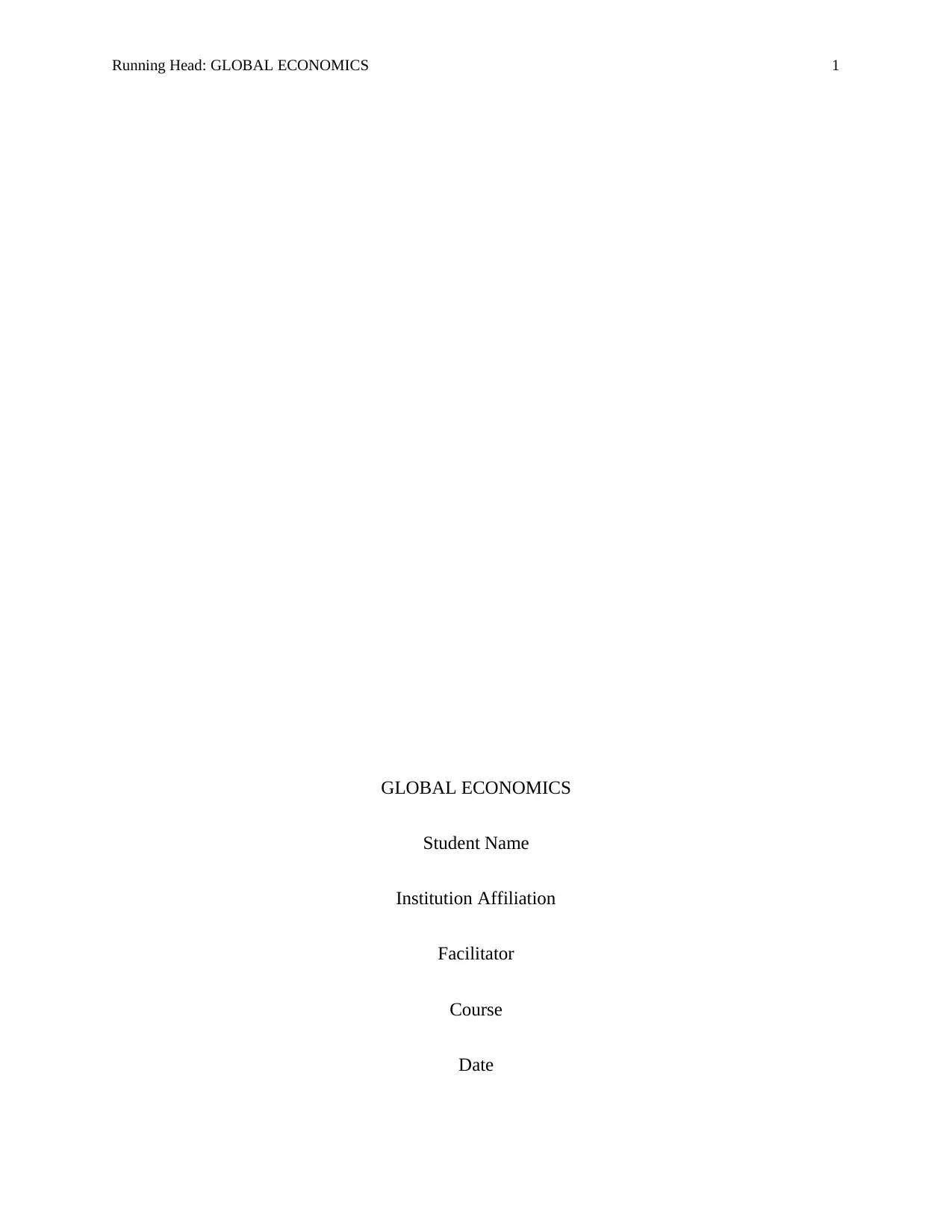
Running Head: GLOBAL ECONOMICS 1
GLOBAL ECONOMICS
Student Name
Institution Affiliation
Facilitator
Course
Date
GLOBAL ECONOMICS
Student Name
Institution Affiliation
Facilitator
Course
Date
Paraphrase This Document
Need a fresh take? Get an instant paraphrase of this document with our AI Paraphraser
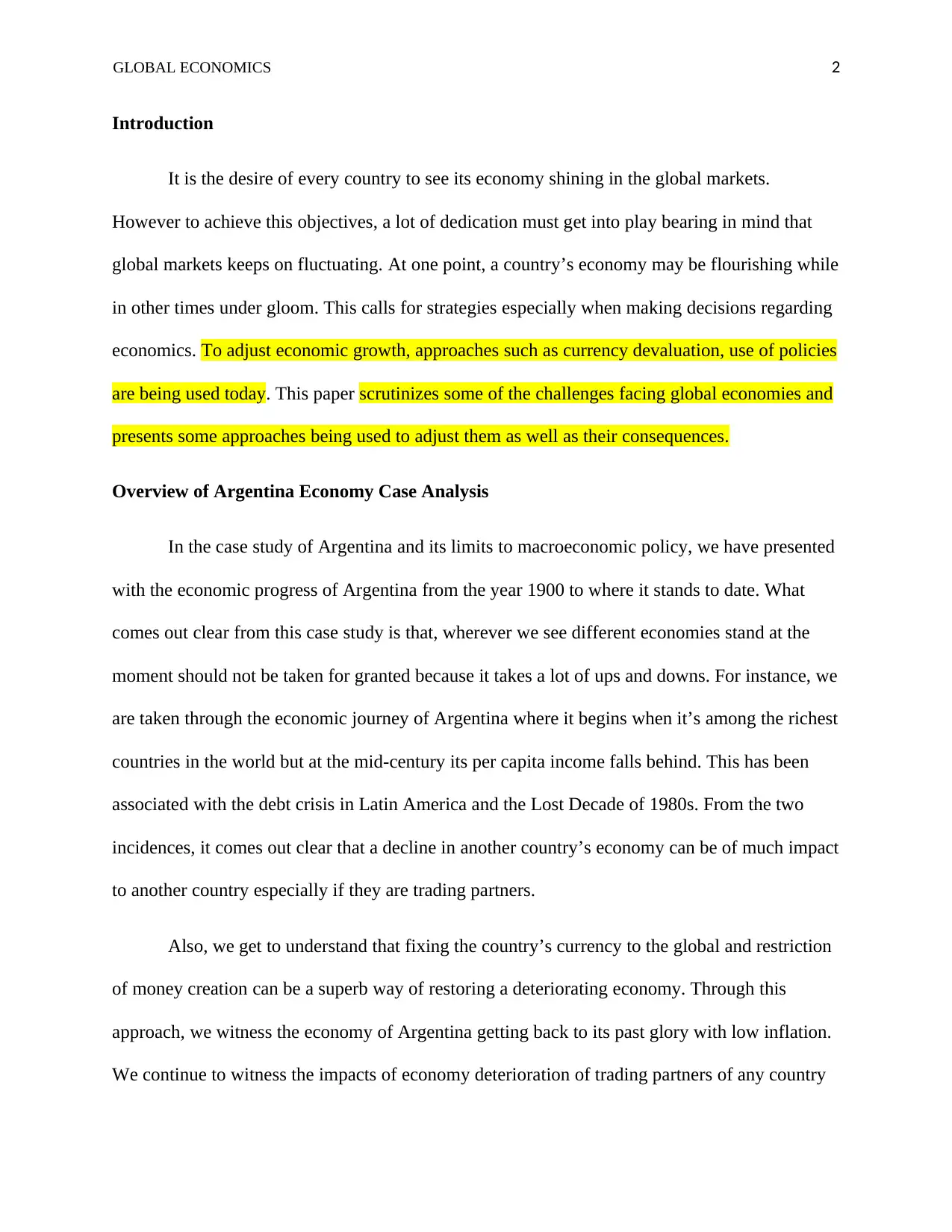
GLOBAL ECONOMICS 2
Introduction
It is the desire of every country to see its economy shining in the global markets.
However to achieve this objectives, a lot of dedication must get into play bearing in mind that
global markets keeps on fluctuating. At one point, a country’s economy may be flourishing while
in other times under gloom. This calls for strategies especially when making decisions regarding
economics. To adjust economic growth, approaches such as currency devaluation, use of policies
are being used today. This paper scrutinizes some of the challenges facing global economies and
presents some approaches being used to adjust them as well as their consequences.
Overview of Argentina Economy Case Analysis
In the case study of Argentina and its limits to macroeconomic policy, we have presented
with the economic progress of Argentina from the year 1900 to where it stands to date. What
comes out clear from this case study is that, wherever we see different economies stand at the
moment should not be taken for granted because it takes a lot of ups and downs. For instance, we
are taken through the economic journey of Argentina where it begins when it’s among the richest
countries in the world but at the mid-century its per capita income falls behind. This has been
associated with the debt crisis in Latin America and the Lost Decade of 1980s. From the two
incidences, it comes out clear that a decline in another country’s economy can be of much impact
to another country especially if they are trading partners.
Also, we get to understand that fixing the country’s currency to the global and restriction
of money creation can be a superb way of restoring a deteriorating economy. Through this
approach, we witness the economy of Argentina getting back to its past glory with low inflation.
We continue to witness the impacts of economy deterioration of trading partners of any country
Introduction
It is the desire of every country to see its economy shining in the global markets.
However to achieve this objectives, a lot of dedication must get into play bearing in mind that
global markets keeps on fluctuating. At one point, a country’s economy may be flourishing while
in other times under gloom. This calls for strategies especially when making decisions regarding
economics. To adjust economic growth, approaches such as currency devaluation, use of policies
are being used today. This paper scrutinizes some of the challenges facing global economies and
presents some approaches being used to adjust them as well as their consequences.
Overview of Argentina Economy Case Analysis
In the case study of Argentina and its limits to macroeconomic policy, we have presented
with the economic progress of Argentina from the year 1900 to where it stands to date. What
comes out clear from this case study is that, wherever we see different economies stand at the
moment should not be taken for granted because it takes a lot of ups and downs. For instance, we
are taken through the economic journey of Argentina where it begins when it’s among the richest
countries in the world but at the mid-century its per capita income falls behind. This has been
associated with the debt crisis in Latin America and the Lost Decade of 1980s. From the two
incidences, it comes out clear that a decline in another country’s economy can be of much impact
to another country especially if they are trading partners.
Also, we get to understand that fixing the country’s currency to the global and restriction
of money creation can be a superb way of restoring a deteriorating economy. Through this
approach, we witness the economy of Argentina getting back to its past glory with low inflation.
We continue to witness the impacts of economy deterioration of trading partners of any country
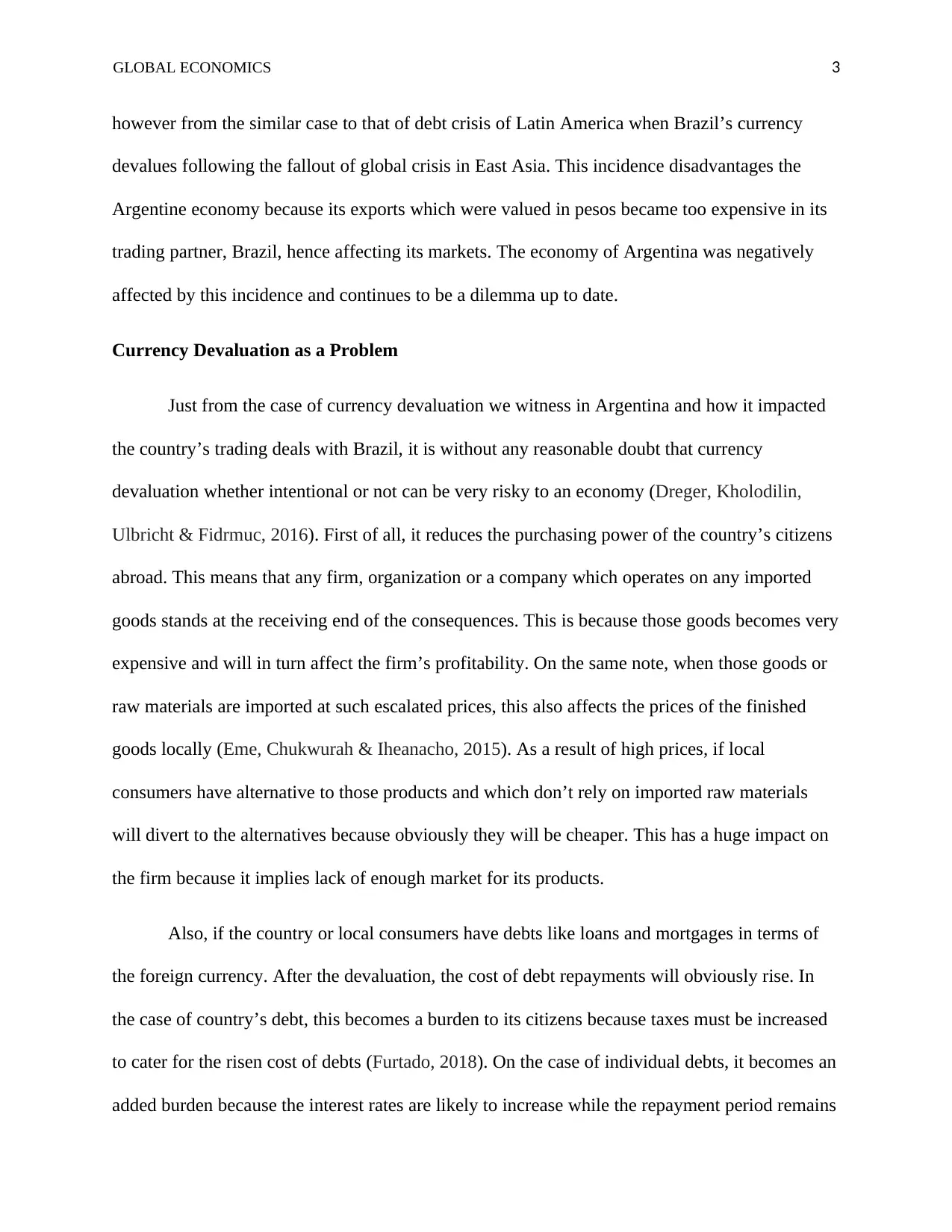
GLOBAL ECONOMICS 3
however from the similar case to that of debt crisis of Latin America when Brazil’s currency
devalues following the fallout of global crisis in East Asia. This incidence disadvantages the
Argentine economy because its exports which were valued in pesos became too expensive in its
trading partner, Brazil, hence affecting its markets. The economy of Argentina was negatively
affected by this incidence and continues to be a dilemma up to date.
Currency Devaluation as a Problem
Just from the case of currency devaluation we witness in Argentina and how it impacted
the country’s trading deals with Brazil, it is without any reasonable doubt that currency
devaluation whether intentional or not can be very risky to an economy (Dreger, Kholodilin,
Ulbricht & Fidrmuc, 2016). First of all, it reduces the purchasing power of the country’s citizens
abroad. This means that any firm, organization or a company which operates on any imported
goods stands at the receiving end of the consequences. This is because those goods becomes very
expensive and will in turn affect the firm’s profitability. On the same note, when those goods or
raw materials are imported at such escalated prices, this also affects the prices of the finished
goods locally (Eme, Chukwurah & Iheanacho, 2015). As a result of high prices, if local
consumers have alternative to those products and which don’t rely on imported raw materials
will divert to the alternatives because obviously they will be cheaper. This has a huge impact on
the firm because it implies lack of enough market for its products.
Also, if the country or local consumers have debts like loans and mortgages in terms of
the foreign currency. After the devaluation, the cost of debt repayments will obviously rise. In
the case of country’s debt, this becomes a burden to its citizens because taxes must be increased
to cater for the risen cost of debts (Furtado, 2018). On the case of individual debts, it becomes an
added burden because the interest rates are likely to increase while the repayment period remains
however from the similar case to that of debt crisis of Latin America when Brazil’s currency
devalues following the fallout of global crisis in East Asia. This incidence disadvantages the
Argentine economy because its exports which were valued in pesos became too expensive in its
trading partner, Brazil, hence affecting its markets. The economy of Argentina was negatively
affected by this incidence and continues to be a dilemma up to date.
Currency Devaluation as a Problem
Just from the case of currency devaluation we witness in Argentina and how it impacted
the country’s trading deals with Brazil, it is without any reasonable doubt that currency
devaluation whether intentional or not can be very risky to an economy (Dreger, Kholodilin,
Ulbricht & Fidrmuc, 2016). First of all, it reduces the purchasing power of the country’s citizens
abroad. This means that any firm, organization or a company which operates on any imported
goods stands at the receiving end of the consequences. This is because those goods becomes very
expensive and will in turn affect the firm’s profitability. On the same note, when those goods or
raw materials are imported at such escalated prices, this also affects the prices of the finished
goods locally (Eme, Chukwurah & Iheanacho, 2015). As a result of high prices, if local
consumers have alternative to those products and which don’t rely on imported raw materials
will divert to the alternatives because obviously they will be cheaper. This has a huge impact on
the firm because it implies lack of enough market for its products.
Also, if the country or local consumers have debts like loans and mortgages in terms of
the foreign currency. After the devaluation, the cost of debt repayments will obviously rise. In
the case of country’s debt, this becomes a burden to its citizens because taxes must be increased
to cater for the risen cost of debts (Furtado, 2018). On the case of individual debts, it becomes an
added burden because the interest rates are likely to increase while the repayment period remains
⊘ This is a preview!⊘
Do you want full access?
Subscribe today to unlock all pages.

Trusted by 1+ million students worldwide
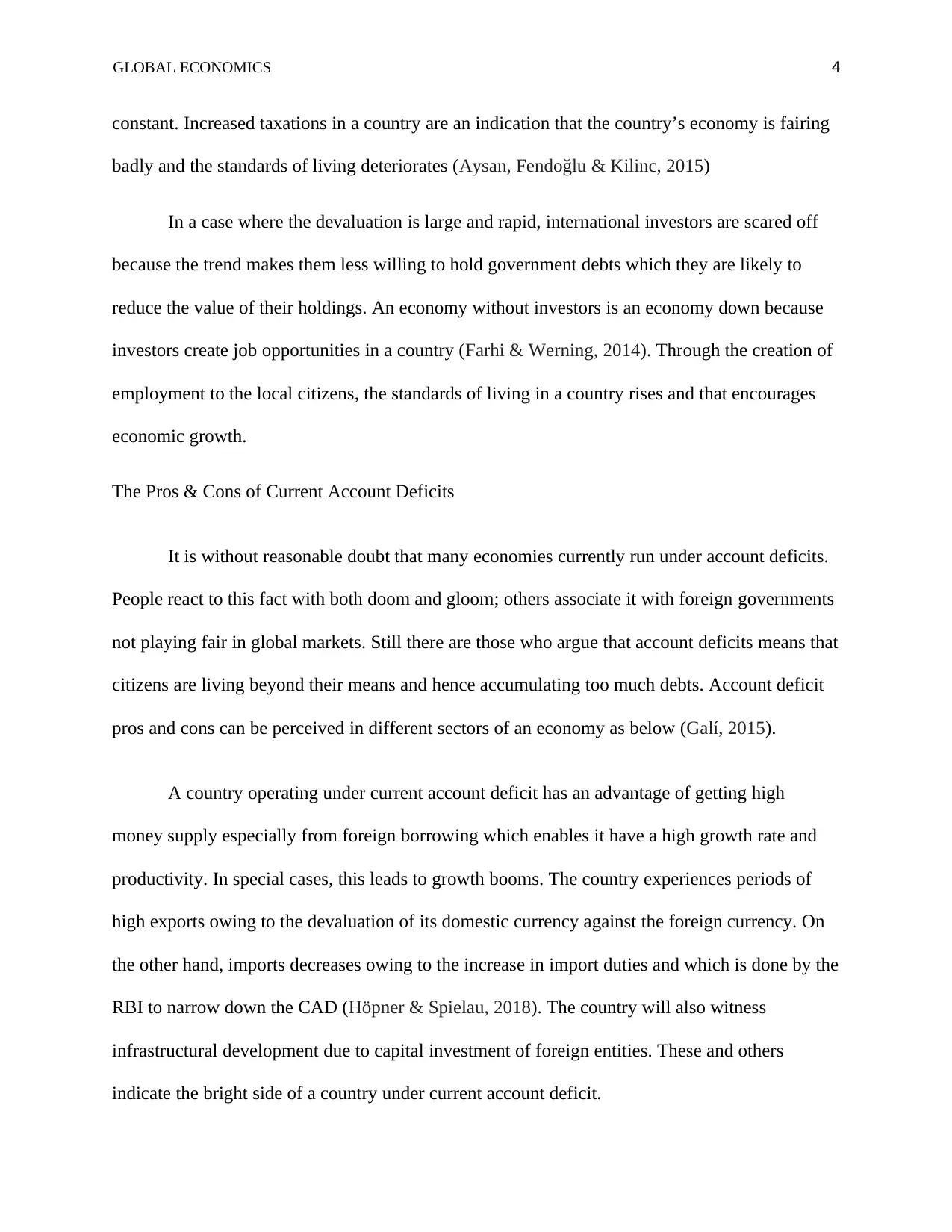
GLOBAL ECONOMICS 4
constant. Increased taxations in a country are an indication that the country’s economy is fairing
badly and the standards of living deteriorates (Aysan, Fendoğlu & Kilinc, 2015)
In a case where the devaluation is large and rapid, international investors are scared off
because the trend makes them less willing to hold government debts which they are likely to
reduce the value of their holdings. An economy without investors is an economy down because
investors create job opportunities in a country (Farhi & Werning, 2014). Through the creation of
employment to the local citizens, the standards of living in a country rises and that encourages
economic growth.
The Pros & Cons of Current Account Deficits
It is without reasonable doubt that many economies currently run under account deficits.
People react to this fact with both doom and gloom; others associate it with foreign governments
not playing fair in global markets. Still there are those who argue that account deficits means that
citizens are living beyond their means and hence accumulating too much debts. Account deficit
pros and cons can be perceived in different sectors of an economy as below (Galí, 2015).
A country operating under current account deficit has an advantage of getting high
money supply especially from foreign borrowing which enables it have a high growth rate and
productivity. In special cases, this leads to growth booms. The country experiences periods of
high exports owing to the devaluation of its domestic currency against the foreign currency. On
the other hand, imports decreases owing to the increase in import duties and which is done by the
RBI to narrow down the CAD (Höpner & Spielau, 2018). The country will also witness
infrastructural development due to capital investment of foreign entities. These and others
indicate the bright side of a country under current account deficit.
constant. Increased taxations in a country are an indication that the country’s economy is fairing
badly and the standards of living deteriorates (Aysan, Fendoğlu & Kilinc, 2015)
In a case where the devaluation is large and rapid, international investors are scared off
because the trend makes them less willing to hold government debts which they are likely to
reduce the value of their holdings. An economy without investors is an economy down because
investors create job opportunities in a country (Farhi & Werning, 2014). Through the creation of
employment to the local citizens, the standards of living in a country rises and that encourages
economic growth.
The Pros & Cons of Current Account Deficits
It is without reasonable doubt that many economies currently run under account deficits.
People react to this fact with both doom and gloom; others associate it with foreign governments
not playing fair in global markets. Still there are those who argue that account deficits means that
citizens are living beyond their means and hence accumulating too much debts. Account deficit
pros and cons can be perceived in different sectors of an economy as below (Galí, 2015).
A country operating under current account deficit has an advantage of getting high
money supply especially from foreign borrowing which enables it have a high growth rate and
productivity. In special cases, this leads to growth booms. The country experiences periods of
high exports owing to the devaluation of its domestic currency against the foreign currency. On
the other hand, imports decreases owing to the increase in import duties and which is done by the
RBI to narrow down the CAD (Höpner & Spielau, 2018). The country will also witness
infrastructural development due to capital investment of foreign entities. These and others
indicate the bright side of a country under current account deficit.
Paraphrase This Document
Need a fresh take? Get an instant paraphrase of this document with our AI Paraphraser
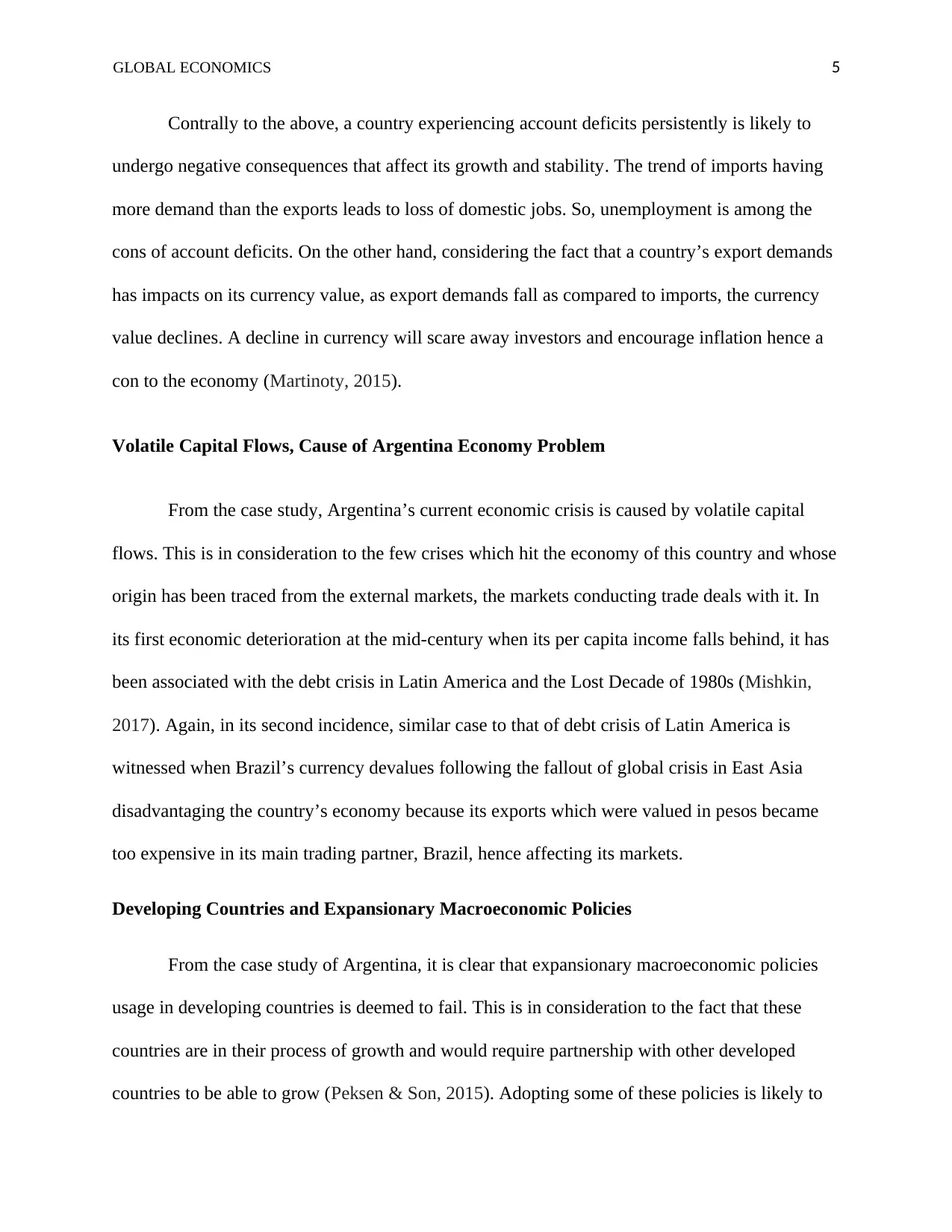
GLOBAL ECONOMICS 5
Contrally to the above, a country experiencing account deficits persistently is likely to
undergo negative consequences that affect its growth and stability. The trend of imports having
more demand than the exports leads to loss of domestic jobs. So, unemployment is among the
cons of account deficits. On the other hand, considering the fact that a country’s export demands
has impacts on its currency value, as export demands fall as compared to imports, the currency
value declines. A decline in currency will scare away investors and encourage inflation hence a
con to the economy (Martinoty, 2015).
Volatile Capital Flows, Cause of Argentina Economy Problem
From the case study, Argentina’s current economic crisis is caused by volatile capital
flows. This is in consideration to the few crises which hit the economy of this country and whose
origin has been traced from the external markets, the markets conducting trade deals with it. In
its first economic deterioration at the mid-century when its per capita income falls behind, it has
been associated with the debt crisis in Latin America and the Lost Decade of 1980s (Mishkin,
2017). Again, in its second incidence, similar case to that of debt crisis of Latin America is
witnessed when Brazil’s currency devalues following the fallout of global crisis in East Asia
disadvantaging the country’s economy because its exports which were valued in pesos became
too expensive in its main trading partner, Brazil, hence affecting its markets.
Developing Countries and Expansionary Macroeconomic Policies
From the case study of Argentina, it is clear that expansionary macroeconomic policies
usage in developing countries is deemed to fail. This is in consideration to the fact that these
countries are in their process of growth and would require partnership with other developed
countries to be able to grow (Peksen & Son, 2015). Adopting some of these policies is likely to
Contrally to the above, a country experiencing account deficits persistently is likely to
undergo negative consequences that affect its growth and stability. The trend of imports having
more demand than the exports leads to loss of domestic jobs. So, unemployment is among the
cons of account deficits. On the other hand, considering the fact that a country’s export demands
has impacts on its currency value, as export demands fall as compared to imports, the currency
value declines. A decline in currency will scare away investors and encourage inflation hence a
con to the economy (Martinoty, 2015).
Volatile Capital Flows, Cause of Argentina Economy Problem
From the case study, Argentina’s current economic crisis is caused by volatile capital
flows. This is in consideration to the few crises which hit the economy of this country and whose
origin has been traced from the external markets, the markets conducting trade deals with it. In
its first economic deterioration at the mid-century when its per capita income falls behind, it has
been associated with the debt crisis in Latin America and the Lost Decade of 1980s (Mishkin,
2017). Again, in its second incidence, similar case to that of debt crisis of Latin America is
witnessed when Brazil’s currency devalues following the fallout of global crisis in East Asia
disadvantaging the country’s economy because its exports which were valued in pesos became
too expensive in its main trading partner, Brazil, hence affecting its markets.
Developing Countries and Expansionary Macroeconomic Policies
From the case study of Argentina, it is clear that expansionary macroeconomic policies
usage in developing countries is deemed to fail. This is in consideration to the fact that these
countries are in their process of growth and would require partnership with other developed
countries to be able to grow (Peksen & Son, 2015). Adopting some of these policies is likely to
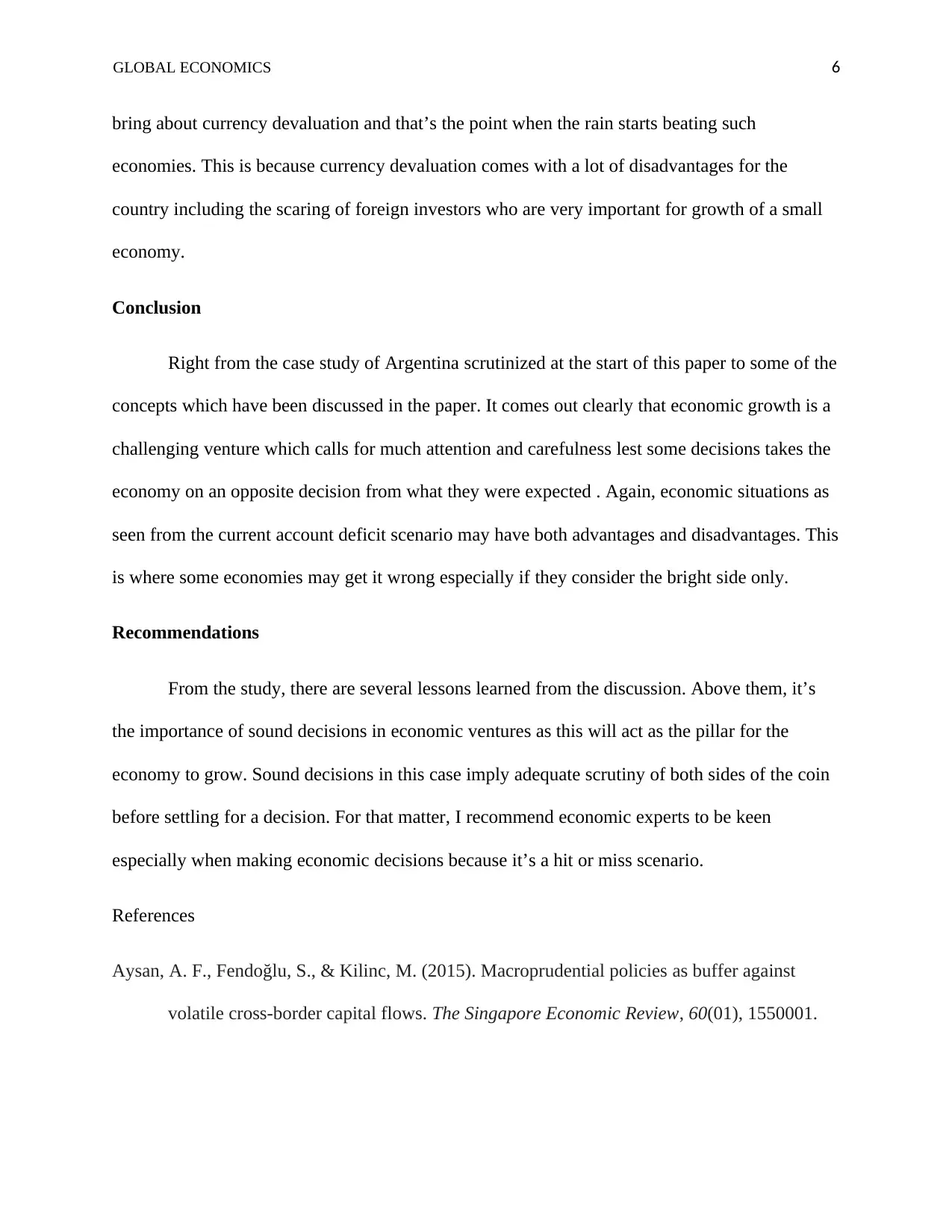
GLOBAL ECONOMICS 6
bring about currency devaluation and that’s the point when the rain starts beating such
economies. This is because currency devaluation comes with a lot of disadvantages for the
country including the scaring of foreign investors who are very important for growth of a small
economy.
Conclusion
Right from the case study of Argentina scrutinized at the start of this paper to some of the
concepts which have been discussed in the paper. It comes out clearly that economic growth is a
challenging venture which calls for much attention and carefulness lest some decisions takes the
economy on an opposite decision from what they were expected . Again, economic situations as
seen from the current account deficit scenario may have both advantages and disadvantages. This
is where some economies may get it wrong especially if they consider the bright side only.
Recommendations
From the study, there are several lessons learned from the discussion. Above them, it’s
the importance of sound decisions in economic ventures as this will act as the pillar for the
economy to grow. Sound decisions in this case imply adequate scrutiny of both sides of the coin
before settling for a decision. For that matter, I recommend economic experts to be keen
especially when making economic decisions because it’s a hit or miss scenario.
References
Aysan, A. F., Fendoğlu, S., & Kilinc, M. (2015). Macroprudential policies as buffer against
volatile cross-border capital flows. The Singapore Economic Review, 60(01), 1550001.
bring about currency devaluation and that’s the point when the rain starts beating such
economies. This is because currency devaluation comes with a lot of disadvantages for the
country including the scaring of foreign investors who are very important for growth of a small
economy.
Conclusion
Right from the case study of Argentina scrutinized at the start of this paper to some of the
concepts which have been discussed in the paper. It comes out clearly that economic growth is a
challenging venture which calls for much attention and carefulness lest some decisions takes the
economy on an opposite decision from what they were expected . Again, economic situations as
seen from the current account deficit scenario may have both advantages and disadvantages. This
is where some economies may get it wrong especially if they consider the bright side only.
Recommendations
From the study, there are several lessons learned from the discussion. Above them, it’s
the importance of sound decisions in economic ventures as this will act as the pillar for the
economy to grow. Sound decisions in this case imply adequate scrutiny of both sides of the coin
before settling for a decision. For that matter, I recommend economic experts to be keen
especially when making economic decisions because it’s a hit or miss scenario.
References
Aysan, A. F., Fendoğlu, S., & Kilinc, M. (2015). Macroprudential policies as buffer against
volatile cross-border capital flows. The Singapore Economic Review, 60(01), 1550001.
⊘ This is a preview!⊘
Do you want full access?
Subscribe today to unlock all pages.

Trusted by 1+ million students worldwide
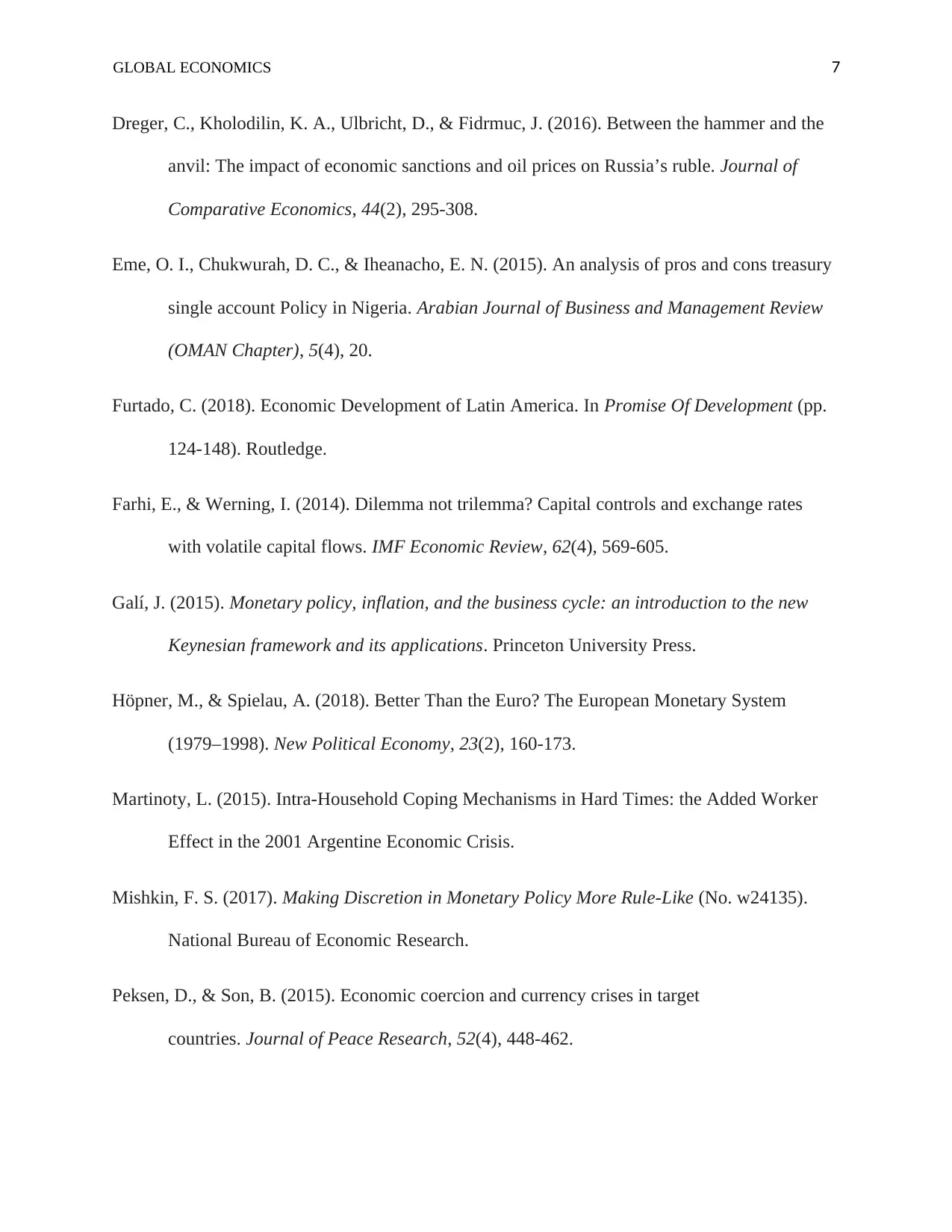
GLOBAL ECONOMICS 7
Dreger, C., Kholodilin, K. A., Ulbricht, D., & Fidrmuc, J. (2016). Between the hammer and the
anvil: The impact of economic sanctions and oil prices on Russia’s ruble. Journal of
Comparative Economics, 44(2), 295-308.
Eme, O. I., Chukwurah, D. C., & Iheanacho, E. N. (2015). An analysis of pros and cons treasury
single account Policy in Nigeria. Arabian Journal of Business and Management Review
(OMAN Chapter), 5(4), 20.
Furtado, C. (2018). Economic Development of Latin America. In Promise Of Development (pp.
124-148). Routledge.
Farhi, E., & Werning, I. (2014). Dilemma not trilemma? Capital controls and exchange rates
with volatile capital flows. IMF Economic Review, 62(4), 569-605.
Galí, J. (2015). Monetary policy, inflation, and the business cycle: an introduction to the new
Keynesian framework and its applications. Princeton University Press.
Höpner, M., & Spielau, A. (2018). Better Than the Euro? The European Monetary System
(1979–1998). New Political Economy, 23(2), 160-173.
Martinoty, L. (2015). Intra-Household Coping Mechanisms in Hard Times: the Added Worker
Effect in the 2001 Argentine Economic Crisis.
Mishkin, F. S. (2017). Making Discretion in Monetary Policy More Rule-Like (No. w24135).
National Bureau of Economic Research.
Peksen, D., & Son, B. (2015). Economic coercion and currency crises in target
countries. Journal of Peace Research, 52(4), 448-462.
Dreger, C., Kholodilin, K. A., Ulbricht, D., & Fidrmuc, J. (2016). Between the hammer and the
anvil: The impact of economic sanctions and oil prices on Russia’s ruble. Journal of
Comparative Economics, 44(2), 295-308.
Eme, O. I., Chukwurah, D. C., & Iheanacho, E. N. (2015). An analysis of pros and cons treasury
single account Policy in Nigeria. Arabian Journal of Business and Management Review
(OMAN Chapter), 5(4), 20.
Furtado, C. (2018). Economic Development of Latin America. In Promise Of Development (pp.
124-148). Routledge.
Farhi, E., & Werning, I. (2014). Dilemma not trilemma? Capital controls and exchange rates
with volatile capital flows. IMF Economic Review, 62(4), 569-605.
Galí, J. (2015). Monetary policy, inflation, and the business cycle: an introduction to the new
Keynesian framework and its applications. Princeton University Press.
Höpner, M., & Spielau, A. (2018). Better Than the Euro? The European Monetary System
(1979–1998). New Political Economy, 23(2), 160-173.
Martinoty, L. (2015). Intra-Household Coping Mechanisms in Hard Times: the Added Worker
Effect in the 2001 Argentine Economic Crisis.
Mishkin, F. S. (2017). Making Discretion in Monetary Policy More Rule-Like (No. w24135).
National Bureau of Economic Research.
Peksen, D., & Son, B. (2015). Economic coercion and currency crises in target
countries. Journal of Peace Research, 52(4), 448-462.
Paraphrase This Document
Need a fresh take? Get an instant paraphrase of this document with our AI Paraphraser
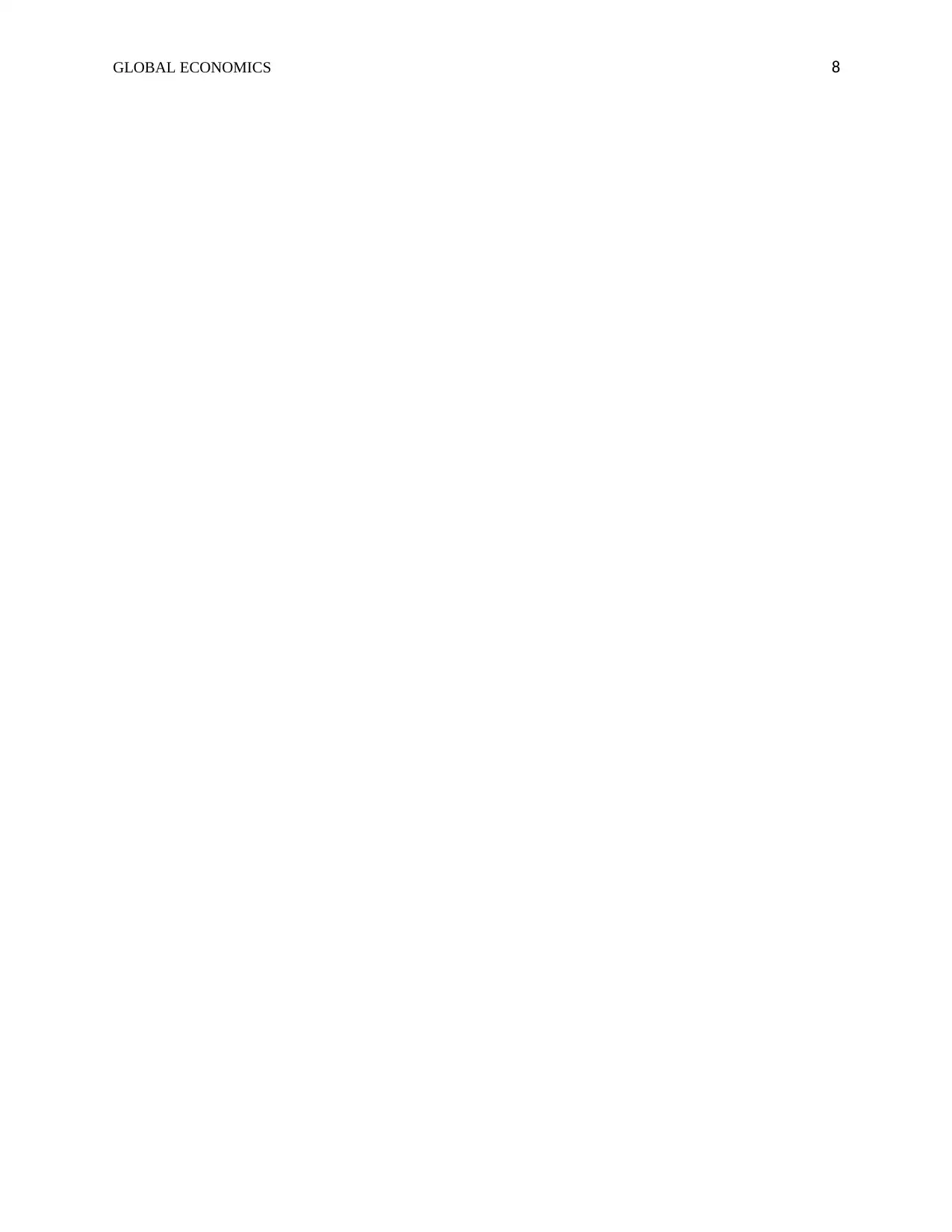
GLOBAL ECONOMICS 8
1 out of 8
Related Documents
Your All-in-One AI-Powered Toolkit for Academic Success.
+13062052269
info@desklib.com
Available 24*7 on WhatsApp / Email
![[object Object]](/_next/static/media/star-bottom.7253800d.svg)
Unlock your academic potential
Copyright © 2020–2025 A2Z Services. All Rights Reserved. Developed and managed by ZUCOL.





